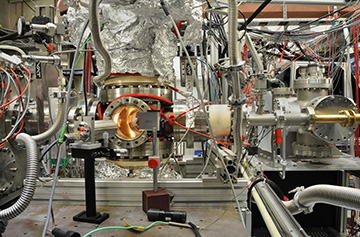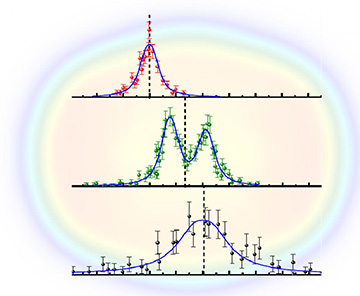GSI’s setup includes a gas-filled optical cell to slow nobelium ions, created one at a time from atomic collisions, and then capture the ions on a tantalum filament. Heating the filament evaporates the accumulated atoms for laser spectroscopy. [Image: G. Otto, GSI] [Enlarge image]
For years, experimental and theoretical physicists have been itching to get at the detailed nuclear structure of the transfermium elements—the super-heavy atoms that pack in more than 100 protons. But measuring those atoms is no mean feat, as they must be created one at a time and don’t stick around for very long.
Now, in a tour de force of laboratory science, an international research team led by Sebastian Raeder at the GSI Helmholtz Center for Heavy Ion Research in Darmstadt, Germany, has used laser spectroscopy to tease out the detailed size and shape of three isotopes of element 102, nobelium (Phys. Rev. Lett., doi: 10.1103/PhysRevLett.120.232503). The techniques developed in the experiments could open the door for a deep dive into the properties of the other transfermium nuclei, which could significantly extend physicists’ understanding of this heretofore largely inaccessible realm.
Superheavy quandaries
One reason the transfermium nuclei provide so tempting a target is that at such large nuclear sizes, the details of the interaction between the strong nuclear force, which holds protons together, and the Coulomb force, which wants to drive them apart, start to tax the capabilities of conventional nuclear models. Modeling of such superheavy elements, for example, predicts the possibility of elongated, nonspherical nuclei, or even of so-called bubble nuclei with a shortage of protons at the center.
Some basic properties of these hefty nuclei can be gleaned from a technique called nuclear-decay spectroscopy. But using that technique to measure the detailed deformations and magnetic moments of the nuclei requires interpretations that depend on the very models that physicists would like to test.
In principle, laser spectroscopy offers a way to probe these hidden nuclear properties without model-dependent inferences. Using this technique, scientists can pull information about nuclear spins, moments and mean charge radii directly from the atomic absorption spectra when the atom is tickled by a UV laser beam. (That’s because the inner electrons in the atom, and thus their transition energies, are influenced by the size, shape and spin properties of the nucleus.) Yet applying even this method to the heaviest atoms, such as nobelium, poses formidable technical challenges, as the atoms must be fashioned synthetically, one at a time, through collisions in atom smashers, and as their half-lives are often measured in a few seconds.
Capturing heavy nuclei with RADRIS
To pin down those elusive atoms, the GSI-led team, which also included scientists from other institutions in Germany and in nine other countries, tapped a recently developed technique called radiation-detected resonance ionization spectroscopy (RADRIS). In RADRIS, molecules of an inert buffer gas, such as argon, are used to slow down and facilitate capture of heavy transfermium nuclei created from atomic collisions, setting them up for a detailed look via laser spectroscopy.
The process begins with the creation of the nobelium atoms themselves, which the team formed, one by one, by firing calcium ions at a solid lead target, to create ions in three isotopes—252No, 243No and 254No—with half-lives ranging from 2.4 to 97 seconds. The team then shunted the ions, at a rate of around four particles per second, into an argon-containing gas buffer cell to slow them down, and used electric fields to guide them for collection onto a tantalum filament, where the ions were neutralized.
After accumulating enough atoms on the filament, the researchers boosted its temperature to a white-hot 1050 °C to release the now-neutral nobelium atoms, which the scientists probed with two laser beams in a two-step photoionization scheme. Finally, the photoions created by the laser were guided electrostatically to one of two silicon detectors. The data on the resonance spectra came from scanning the frequency shift of the pumping laser and relating it to the photoion count at the detectors.
Nuclear football
Measured excitation spectra and best-fit curves for 254No (top), 253No (middle), and 252No (bottom). [Image: S. Raeder, GSI] [Enlarge image]
The spectroscopic results revealed that the nobelium nucleus is, as predicted by theoretical models, not spherical but elongated, somewhat like an American football. Also as predicted, two of the isotopes, 252No and 254No, have a proton density around 12 percent lower at the center than on the surface. And the excitation spectra of 253No showed a hyperfine, two-peak structure—again expected, owing to the presence of an odd number of neutrons in that isotope.
The successful demonstration of the technique on nobelium should make other superheavy atoms ripe for a nuclear glimpse. For the time being, though, such experiments will need to take place at GSI, which currently operates the world’s only setup of this type.


